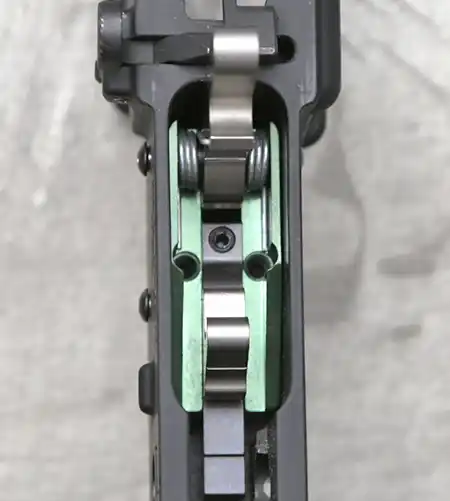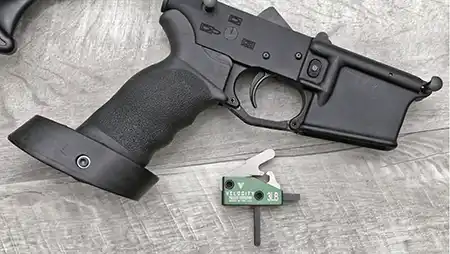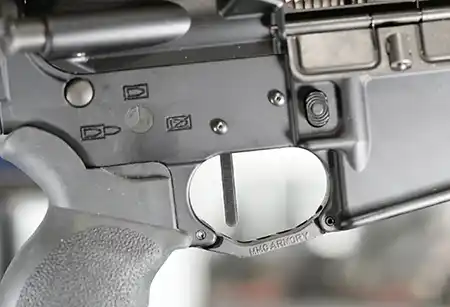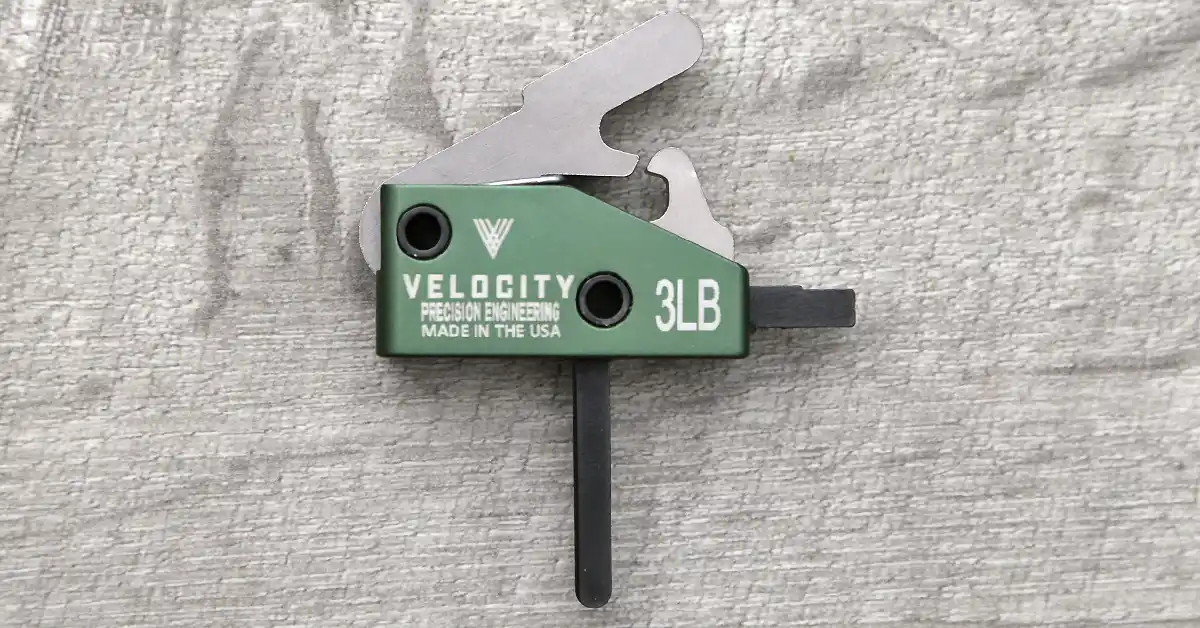Dropping a Velocity Classic AR Trigger into my rifle made a noticeable difference, and was probably long overdue. Since it was built mostly from spare parts, it had a budget mil-spec trigger. With a pull weight of around six pounds, it was also much heavier than I preferred for this “longer-range plinker”. This is one rifle that would certainly benefit from a lighter trigger. A quick check of the Velocity website revealed that I could get all my favorite trigger options in a single unit.
Velocity Classic AR Trigger details
These single-stage triggers are the drop-in, or “cassette” type triggers. While that certainly makes the installation simple, it also means it’s not exactly field-serviceable. I don’t see that as a concern though, as Velocity builds and sells very high-quality products. No corners are cut, and with more than 35 years of experience, users should have confidence in the reliability of these triggers.

Contributing to the smoothness and reliability of Velocity triggers is their use of ArmorLube DLC. This is a next-generation diamond-like carbon firearm coating, and it also eliminates the need for any additional lubricants. By combining a low coefficient of friction and high micro-hardness, it maximizes weapon performance, durability, and reliability. The result is greater wear resistance over the life of the trigger, even in the most extreme conditions.
Velocity Classic AR Trigger options
Before choosing the trigger, consideration needs to be given to the application. Steel case ammo may require a stronger hammer and hammer spring. If you plan on shooting the cheaper steel case ammo (I’m not judging), get the Velocity “Steel Case” version of their trigger. That will ensure more reliable ignition. It will still work fine with brass ammo and .22 ammo too. Velocity also offers a dedicated trigger for 9mm/PCC builds. The only potential downside to either is that they’re limited to the 4-pound pull weight.
That out of the way, it was time to choose the actual trigger shape. Velocity offers triggers that are curved, straight, or straight with a finger stop. My preference is a straight trigger, with their finger stop model a close second. Since I don’t shoot steel-cased ammo, there’s a drop-down to select the pull weight. Options include 3, 3.5, 4, and 4.5-pound pull weights. Some of my rimfire rifles have triggers that can be measured in ounces. So those numbers seem heavy. But what works for a bolt-action rimfire off a bench isn’t necessarily ideal for a semi-auto centerfire. Three pounds seems like the sweet spot for me with this rifle.
Velocity Classic AR Trigger installation
While I’ve embedded the installation video below, I’m going to also provide the relevant installation steps. Note that at no time should thread lock of any sort be used. It’s not required, and not necessary. Start by making sure the rifle is unloaded, then dry fire it before separating the upper from the lower. Push out the trigger pins, and take out the trigger and all related parts. Remove the grip, and then the safety.

Drop the Velocity Classic AR Trigger into the lower, then reinstall the safety. Reinstall the trigger pins. Using the included wrench, tighten the two screws on either side of the hammer. Then install the included 8/32 x 1/8″ set screws on top of those screws. These keep the pins from walking out, which is why thread locker isn’t needed. Reinstall the safety plunger, spring, and the grip itself. With a thumb on the hammer, cock it back and test the safety. Once it’s confirmed that the safety is working, the upper can be replaced.
*
*
A definite improvement
Before hitting the range, I spent some time dry-firing my rifle. This allowed me to get familiar with it, without some of the distractions of the range. It’s not always the same as live fire, but it’s nice to be able to focus on the trigger 100%. Needless to say, the Velocity Classic AR trigger was a noticeable improvement over the previous one. That bit of creep, as well as the considerable pull required for the break, was gone. It still requires an intentional squeeze of the trigger, but now it breaks once pressure is applied, without any slop or grit. This is followed by a very short reset. Six pounds may not be a lot, but it’s much more than most of my rifles. And the Velocity may measure at 3 pounds but it feels even lighter. It is indeed a nice and crisp trigger, as advertised.

Although I was only engaging targets out to a couple hundred yards, I’m certain that the lighter pull improved my shooting. No one is going to mistake me for an expert marksman, but the Velocity trigger has eliminated one of the weak points of this rifle. Velocity mentions that it “makes your AR feel like a bolt action rifle”, and they’re not wrong. While shooting prone off my mat, their trigger does give me some bolt action vibes.
A trigger is just a trigger, right?
Nope. There are plenty of aftermarket triggers available for this platform. If you’re going to buy one, it’s hard to beat Velocity. The owner, Tom Vehr, worked for one of the largest trigger manufacturers in the world. After 14 years there, he moved on to Knight Rifles, where he was responsible for the production of nearly half a million trigger assemblies. And then in 2008, he created Vehr Manufacturing, which is the parent company of Velocity Triggers. He’s got over 35 years of experience designing, manufacturing, and assembling triggers. In other words, he knows his stuff.
Current MSRP for the trigger shown is $149.95, which makes it an affordable and reliable upgrade. If you’re looking to improve your accuracy, simplify your trigger group, and get a nice light break with a short reset, check out the velocitytriggers.com website.
As always, I’d like to thank Velocity Triggers for providing their trigger for my testing and evaluation. Their website is easy to navigate, ordering is simple, and customer service is excellent. And of course, they offer some excellent products.
Do you own, or have you tried a Velocity trigger? Feel free to share your thoughts in the comments below.
